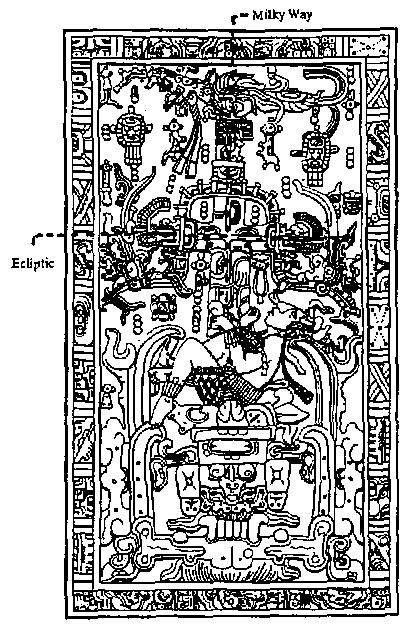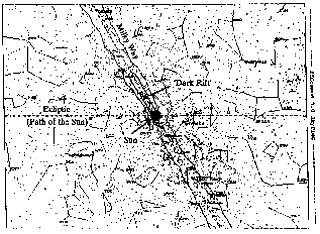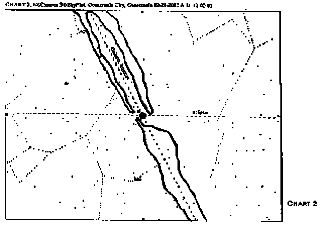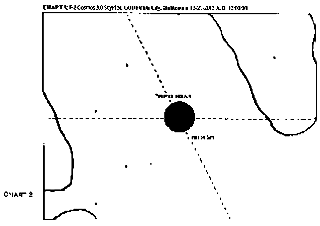The Black Road To The Sacred Tree by Robertino Solàrion
Dallas, Texas, 14
December 2000
The Dallas Morning News. 15 November 1998. University of Texas McDonald Observatory. "A Mayan creation story says the world was formed when the Milky Way, which they called The World Tree, was raised into the sky. The Great Celestial Bird landed in its branches. This bird may be represented by Cassiopeia, which looks like a bird's outstretched wings. Cassiopeia is high in the north this evening." See The Hyperborea Sky Diagrams
THE MAYAN CALENDAR by Peter Meyer is an excellent discussion of the mathematical "calendrics" or mechanics of the Mayan Calendar, so if you do not fully grasp the ideas of the "Long Count" and the "Short Count", you are advised to refer to Peter Meyer's essay. From this appended John Major Jenkins essay, there is a link to some material about "Hyperborea" that was written by the late Terence McKenna. May he rest in peace; however, his so-called "Hyperborea" material is really nothing more than a lot of glitzy new-age mumbo-jumbo, in my opinion, with no practical relevance to history per se. 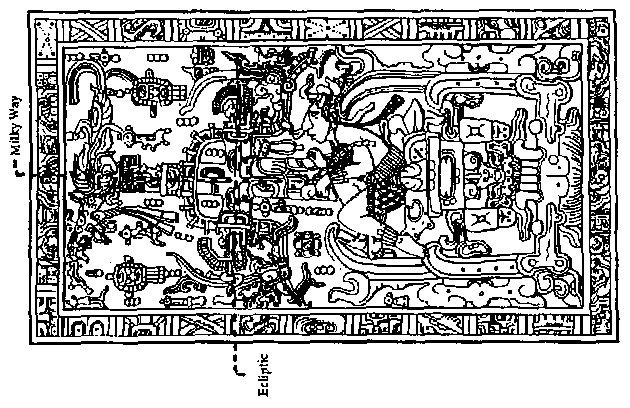 The preceding GIF is Diagram 1 in the following essay. To see the other diagrams, go to the URL for the Jenkins' essay. Curiously, this GIF is the exact same image used by such "ancient astronaut" theorists as Erich Van Daniken in CHARIOTS OF THE GODS, to depict an "ancient astronaut" at the controls of an "ancient spaceship". Note that there are Christmas Tree type objects dangling from the limbs of this Mayan "Sacred Tree". The "umbilical cord" that Jenkins mentions would of course refer to the electromagnetic "umbilicus" attaching the Earth to "Hyperborea". This concept of dangling "ornaments" was incorporated into the cover design of my book. Below is another depiction of the Sacred Mayan Tree. 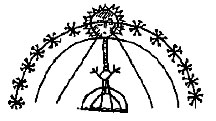 Rather than intersperse any comments throughout this text itself, I'll put all of them here at the beginning. The first point that I must emphasize is that this author, despite his extraordinary work otherwise, did not view this Mayan "Sacred Tree" in terms of a PHYSICAL Cosmic Tree. NOTA BENE in one of the footnotes that he cites HAMLET'S MILL by Giorgio de Santillana and Hertha von Dechend, who wrote about the Finnish Kalevala and "Nail Of The North"! At least Jenkins was aware of their research, although nowhere does he include a mention of Dr. Immanuel Velikovsky's essay THE NIGHT SUN or Zecharia Sitchin's THE EARTH CHRONICLES and the Planet Nibiru. Thus, like I, you rather have to read between the lines to ascertain exactly what Jenkins' ultimate conclusion might have been. As did the authors of HAMLET'S MILL, Jenkins also concludes that the "Sacred Tree" or "Cosmic Millstone" referred ONLY to the idea of the Precession of the Equinoxes. Theoretically, that is all well and good, but it misses the point entirely. "The Sacred Tree" (still symbolized even today as a formerly pagan "Paradise Christmas Tree") reflects the electromagnetic tethering of the Hyperborean Planet Nibiru, Rogue Planet X, Planet of the Crossing, to the Earth's North Pole. Whether the "crossing" point is affected by the separate phenomenon of Precession is, in essence, irrelevant. They are independent variables. There is a lot of discussion by both Jenkins and Meyer regarding the "starting point" of the Mayan Calendar (0.0.0.0.0), its end point (13.0.0.0.0) and its proper correlation with our modern Gregorian Calendar. The "Thompson Calculation" is the most widely accepted, because it relies on evidence from contemporary Guatemala, although Meyer states that others have calculated the "starting point" and ended up with dates ranging from 200 years earlier to 500 years later than 2012, creating a 700-year "end window", as it were. However, BECAUSE Dr. Velikovsky's dates of 1587 BCE and 762-687 BCE just "happen" to agree with the Thompson Calculation lends significant credence to it, at least in terms of a cycle relating to the orbital length in Earth Years of the Planet Nibiru, i.e., 3,600 years. Thus, it rather takes one's breath away to read in Jenkins' essay below that the most reasonable year for discerning the commencement of the Mayan "Tzolkin" Count is the year 679 BCE, only 8 years later than 687! The conclusion is forced automatically that the Mayas attempted to begin their Tzolkin Count at the time of the last dissolution of the "Sacred Tree", when "Cosmic Forces" half a world away annihilated the Assyrian Army of King Sennacherib in the Sinai Battle of Pelusium. As you know, for quite sometime one of my own basic premises has been that there are exactly 2,700 years between 687 BCE and 2013 CE (end of 2012, to be exact). This, however, is the first and only time that I have seen independent data to reinforce this comparison, and that is the exciting part of this discovery. Incidentally, in Assyrian history the year 679 BCE included the death of King Sennacherib and the accession of his son Esarhaddon, an event which marked an important turning point in Assyrian history, as well as in Egyptian history with the advent of their most important Dynasty 19, that of Seti The Great and Ramses The Great. See Dr. Velikovsky's reconstructed chronology in the AGES IN CHAOS series for more information. Also, note below that Jenkins mentions a Mayan calendrical end-date "window" that lasts for 10 years, or 5 years on either side of 2012, i.e., 2007-2017. As I have noted in a separate essay, when calculating a visibility factor and transit speed of "Rogue Planet X" from the Oort Cloud, I hypothesized a "naked-eye" arrival moment corresponding in general to the Passover Season, which itself originated in 1587 BCE a few days following the "passing over" or "crossing over" of the God Yahweh (i.e., Archon Y) from Heaven to Earth. Even though Sitchin ultimately refused to equate Yahweh with Nibiruan Crown-Prince Enlil, R.A. Boulay mentioned explicitly how the fleeing Israelites followed a "heavenly beam" of some sort that guided them in their escape; and Boulay also wrote about how this reptilian "Saurian God" was a "shy god" who refused to show himself to Moses for fear that Moses would have had a heart attack from sudden terror. Regarding "The Sacred Tree" itself, it is not simply a point at which on some future date the Sun or Moon might happen to "cross" the Ecliptic's intersection with the Galactic Equator (or Milky Way). It is fundamentally different. The point at which these two lines intersect -- the "dark rift" or "Black Road" -- undoubtedly marks the "point of the crossing"! Sitchin himself, in deciphering the Sumerian ENUMA ELISH, states that this planet first appears in the Constellation of Sagittarius where this Mayan "dark rift" is located. Jenkins determined that the overall Mayan Calendar is designed to pinpoint some future date connected with the Winter Solstice. Even though Mayan/Olmec civilization itself might not be so old as the retrograde projections of their historical calendar, the ultimate construction of the calendar was intended to designate an END DATE, or a PREDICTION DATE, for a future event -- as if to warn the future of this deadly eventuality. Think about that! The Planet X Nibiru "crosses" over from some as yet unidentifiable area of Space at the point where the Galactic Equator intersects our Solar System's Ecliptic, in the "dark rift" of the Constellation of Sagittarius. At the time of the Winter Solstice, our Sun is aligned with this region of Space; thus, the brightness of the Sun will obscure our visibility of Sagittarius. Note below that Jenkins writes that just prior to sunrise around the Winter Solstice, if one were to look eastwards, one might see an "object" rising slightly higher and in conjunction with the rising Sun itself. Then recall from Sitchin that the Sumerian (Assyrian or Babylonian) priest-astronomers would go out into the dark deserts to watch for the "first sighting" of the arrival of Nibiru. Not having the technology of a Hubble Telescope, these ancient Sumerians would have looked at the dawn winter sky for evidence. Then here, according to Jenkins, this "Sacred Tree" makes its way upwards and northwards from Sagittarius towards the "Heart of the Sky" or the North Polar Region, where "Santa Claus" is still said to abide. Polaris is at the "Heart of the Sky"! And as Jenkins writes below, "the Sacred Tree is, in fact, at the center of the entire corpus of Mayan Creation Myths"! Fasten your seat belts! Crossover is just ahead!
THE HOW AND WHY OF THE MAYAN END DATE IN 2012 A.D. by John Major Jenkins May 23, 1994 Originally published in the Dec-Jan '95 issue of Mountain Astrologer. Why did the ancient Mayan or pre-Maya choose December 21st, 2012 A.D., as the end of their Long Count calendar? This article will cover some recent research. Scholars have known for decades that the 13-baktun cycle of the Mayan "Long Count" system of timekeeping was set to end precisely on a winter solstice, and that this system was put in place some 2300 years ago. This amazing fact -- that ancient Mesoamerican skywatchers were able to pinpoint a winter solstice far off into the future -- has not been dealt with by Mayanists. And why did they choose the year 2012? One immediately gets the impression that there is a very strange mystery to be confronted here. I will be building upon a clue to this mystery reported by epigrapher Linda Schele in Maya Cosmos (1994). This article is the natural culmination of the research relating to the Mayan Long Count and the precession of the equinoxes that I explored in my recent book Tzolkin: Visionary Perspectives and Calendar Studies (Borderlands Science and Research Foundation, 1994).
The Mayan Long Count Just some basics to get us started. The Maya were adept skywatchers. Their Classic Period is thought to have lasted from 200 A.D. to 900 A.D., but recent archeological findings are pushing back the dawn of Mayan civilization in Mesoamerica. Large ruin sites indicating high culture with distinctly Mayan antecedents are being found in the jungles of Guatemala dating back to before the common era. And even before this, the Olmec civilization flourished and developed the sacred count of 260 days known as the tzolkin. The early Maya adopted two different time keeping systems, the "Short Count" and the Long Count. The Short Count derives from combining the tzolkin cycle with the solar year and the Venus cycle of 584 days. In this way, "short" periods of 13, 52 and 104 years are generated. Unfortunately, we won't have occasion to dwell on the properties of the so-called Short Count system here. The Long Count system is somewhat more abstract, yet is also related to certain astronomical cycles. It is based upon nested cycles of days multiplied at each level by that key Mayan number, twenty:
Notice that the only exception to multiplying by twenty is at the tun level, where the uinal period is instead multiplied by 18 to make the 360-day tun. The Maya employed this counting system to track an unbroken sequence of days from the time it was inaugurated. The Mayan scholar Munro Edmonson believes that the Long Count was put in place around 355 B.C. This may be so, but the oldest Long Count date as yet found corresponds to 32 B.C. We find Long Count dates in the archeological record beginning with the baktun place value and separated by dots. For example: 6.19.19.0.0 equals 6 baktuns, 19 katuns, 19 tuns, 0 uinals and 0 days. Each baktun has 144000 days, each katun has 7200 days, and so on. If we add up all the values we find that 6.19.19.0.0 indicates a total of 1007640 days have elapsed since the Zero Date of 0.0.0.0.0. The much discussed 13-baktun cycle is completed 1872000 days (13 baktuns) after 0.0.0.0.0. This period of time is the so called Mayan "Great Cycle" of the Long Count and equals 5125.36 years. But how are we to relate this to a time frame we can understand? How does this Long Count relate to our Gregorian calendar? This problem of correlating Mayan time with "western" time has occupied Mayan scholars since the beginning. The standard question to answer became: what does 0.0.0.0.0 (the Long Count "beginning" point) equal in the Gregorian calendar? When this question is answered, archeological inscriptions can be put into their proper historical context and the end date of the 13-baktun cycle can be calculated. After years of considering data from varied fields such as astronomy, ethnography, archeology and iconography, J. Eric S. Thompson determined that 0.0.0.0.0 corresponded to the Julian date 584283, which equals August 11th, 3114 B.C. in our Gregorian calendar. This means that the end date of 13.0.0.0.0, some 5125 years later, is December 21st, 2012 A.D.1 The relationship between the Long Count and Short Count has always been internally consistent (both were tracked alongside each other in an unbroken sequence since their conception). Now it is very interesting to note that an aspect of the "Short Count", namely, the sacred tzolkin count of 260 days, is still being followed in the highlands of Guatemala. As the Mayan scholar Munro Edmonson shows in The Book of the Year, this last surviving flicker of a calendar tradition some 3000 years old supports the Thompson correlation of 584283. Edmonson also states that the Long Count was begun by the Maya or pre-Maya around 355 B.C., but there is reason to believe that the Long Count system was being perfected for at least 200 years prior to that date. The point of interest for these early astronomers seems to have been the projected end date in 2012 A.D., rather than the beginning date in 3114 B.C. Having determined the end date in 2012 (for reasons we will come to shortly), and calling it 13.0.0.0.0, they thus proclaimed themselves to be living in the 6th baktun of the Great Cycle. The later Maya certainly attributed much mythological significance to the beginning date, relating it to the birth of their deities, but it now seems certain that the placement of the Long Count hinges upon its calculated end point. Why did early Mesoamerican skywatchers pick a date some 2300 years into the future and, in fact, how did they pinpoint an accurate winter solstice? With all these considerations one begins to suspect that, for some reason, the ancient New World astronomers were tracking precession.
The Precession The precession of the equinoxes, also known as the Platonic Year, is caused by the slow wobbling of the earth's polar axis. Right now this axis roughly points to Polaris, the "Pole Star," but this changes slowly over long periods of time. The earth's wobble causes the position of the seasonal quarters to slowly precess against the background of stars. For example, right now, the winter solstice position is in the constellation of Sagittarius. But 2000 years ago it was in Capricorn. Since then, it has precessed backward almost one full sign. It is generally thought that the Greek astronomer Hipparchus was the first to discover precession around 128 B.C. Yet scholarship indicates that more ancient Old World cultures such as the Egyptians (see Schwaller de Lubicz's book Sacred Science) and Babylonians also knew about the precession. I have concluded that even cultures with simple horizon astronomy and oral records passed down for a hundred years or so, would notice the slow shifting of the heavens. For example, imagine that you lived in an environment suited for accurately demarcated horizon astronomy. Even if this wasn't the case, you might erect monoliths to sight the horizon position of, most likely, the dawning winter solstice sun. This position in relation to background stars could be accurately preserved in oral verse or wisdom teachings, to be passed down for centuries. Since precession will change this position at the rate of 1 degree every 72 years, within the relatively short time of 100 years or so, a noticeable change will have occurred. The point of this is simple. To early cultures attuned to the subtle movements of the sky, precession would not have been hard to notice.2 The Maya are not generally credited with knowing about the precession of the equinoxes. But considering everything else we know about the amazing sophistication of Mesoamerican astronomy, can we realistically continue to deny them this? Many of the as yet undeciphered hieroglyphs may ultimately describe precessional myths. Furthermore, as I show in my book Tzolkin: Visionary Perspectives and Calendar Studies, the Long Count is perfectly suited for predicting future seasonal quarters, indefinitely, and precession is automatically accounted for. Some of the most incredible aspects of Mayan cosmo-conception are just now being discovered. As was the case with the state of Egyptology in the 1870's, we still have a lot to learn. In addition, Mayanists like Gordon Brotherston (The Book of the Fourth World) consider precessional knowledge among Mesoamerican cultures to be more than likely.
The Sacred Tree We are still trying to answer these questions: What is so important about the winter solstice of 2012 and, exactly how were calculations made so accurately, considering that precession should make them exceedingly difficult? If we make a standard horoscope chart for December 21st, 2012 A.D., nothing very unusual appears. In this way I was led astray in my search until Linda Schele provided a clue in the recent book Maya Cosmos. Probably the most exciting breakthrough in this book is her identification of the astronomical meaning of the Mayan Sacred Tree. Drawing from an impressive amount of iconographic evidence, and generously sharing the process by which she arrived at her discovery, the Sacred Tree is found to be none other than the crossing point of the ecliptic with the band of the Milky Way. Indeed, the Milky Way seems to have played an important role in Mayan imagery. For example, an incised bone from 8th century Tikal depicts a long sinking canoe containing various deities. This is a picture of the night sky and the canoe is the Milky Way, sinking below the horizon as the night progresses, and carrying with it deities representing the nearby constellations. The incredible Mayan site of Palenque is filled with Sacred Tree motifs and references to astronomical events. In their book Forest of Kings, Schele and Freidel suggested that the Sacred Tree referred to the ecliptic. Apparently that was only part of the picture, for the Sacred Tree that Pacal ascends in death is more than just the ecliptic, it is the sacred doorway to the underworld. The crossing point of Milky Way and ecliptic is this doorway and represents the sacred source and origin. In the following diagram of the well known sarcophagus carving, notice that the Milky Way tree serves as an extension of Pacal's umbilicus. The umbilicus is a human being's entrance into life, and entrance into death as well:
Diagram 1: Pacal and the Sacred Tree. We may also remember at this point that the tzolkin calendar is said to spring from the Sacred Tree. The Sacred Tree is, in fact, at the center of the entire corpus of Mayan Creation Myths. We should definitely explore the nature of this astronomical feature. The first question that came up for me was as follows. Since Lord (Ahau) Pacal is, by way of divine kingship, equated with the sun, and he is portrayed "entering" the Sacred Tree on his famous sarcophagus lid, on what day does the sun come around to conjunct the crossing point of ecliptic and Milky Way? This would be an important date. In the pre-dawn skies of this date, the Milky Way would be seen to arch overhead from the region of Polaris (Heart of Sky) and would point right at where the sun rises. This (and the corollary date 6 months later) is the only date when the Sun/Lord could jump from the ecliptic track and travel the Milky Way up and around the vault of heaven to the region of Polaris, there to enter the "Heart of Sky." It should be mentioned that 1300 years ago, during the zenith of Palenque's glory, Polaris was much less an exact "Pole Star" than it is now. Schele demonstrates that it wasn't a Pole Star that the Maya mythologized in this regard, it was the unmarked polar "dark region" symbolizing death and the underworld around which everything was observed to revolve. Life revolves around death -- a characteristically Mayan belief. The dates on which the sun conjuncts the "Sacred Tree" are thus very important. These dates will change with precession. Schele doesn't pursue this line of reasoning, however, and doesn't even mention that these dates might be significant. If we go back to 755 A.D., we find that the sun conjuncts the Sacred Tree on December 3rd. I should point out here that the Milky Way is a wide band, and perhaps a 10-day range of dates should be considered. To start with, however, I use the exact center of the Milky Way band that one finds on star charts, known as the "Galactic Equator" (not to be confused with Galactic Center). Where the Galactic Equator crosses the ecliptic in Sagittarius just happens to be where the dark rift in the Milky Way begins. This is a dark bifurcation in the Milky Way caused by interstellar dust clouds. To observers on earth, it appears as a dark road which begins near the ecliptic and stretches along the Milky Way up towards Polaris. The Maya today are quite aware of this feature; the Quiche Maya call it Xibalba (the "road to Xibalba") and the Chorti Maya call it the "camino de Santiago". In Dennis Tedlock's translation of the Popol Vuh, we find that the ancient Maya called it the "Black Road". The Hero Twins Hunahpu and Xbalanque must journey down this road to battle the Lords of Xibalba. (Tedlock 334, 358). Furthermore, what Schele has identified as the Sacred Tree was known to the ancient Quiche simply as "Crossroads." This celestial feature was not marginal in ancient Mayan thought and is still recognized even today. In terms of how this feature was mythologized, it seems that when a planet, the sun, or the moon entered the dark cleft of the Milky Way in Sagittarius (which happens to be the exact center of the Milky Way, the Galactic Equator), entrance to the underworld road was possible, which could then take the journeyer up to the Heart of Sky. Shamanic vision rites were probably involved in this scenario. In the Yucatan, underground caves were ritual places used by shaman to journey to the underworld. Schele explains that "Mayan mythology identifies the Road to Xibalba as going through a cave" (Forest of Kings, 209). Here we have a metaphorical reference to the "dark rift" in the Milky Way by way of its terrestrial counterpart, a syncretism between earth and sky which is characteristic of Mayan thinking. Above all, what is becoming apparent from the corpus of Mayan Creation Myths is that creation seems to have taken place at a celestial crossroads -- the crossing point of ecliptic and Milky Way. To clarify this ever growing picture, we should stop here and plot out some charts. In addition to the detailed star maps from Norton's 2000.0 Star Atlas which allowed me to pinpoint the crossing point of Galactic Equator and ecliptic, I use EZCosmos to plot these positions.3 What I found answers the question of why the Maya chose the winter solstice of 2012, a problem seemingly avoided by astronomers and Mayanists alike. While it is true that the sun conjuncts the Sacred Tree on December 3rd in the year 755 A.D., over the centuries precession has caused the conjunction date to approach the winter solstice. So, how close are we to perfect conjunction today? Exactly when might we expect the winter solstice sun to conjunct the crossing point of Galactic Equator and ecliptic -- the Mayan Sacred Tree? Any astronomer will tell you that, presently, the Milky Way crosses the ecliptic through the constellation of Sagittarius and this area is rich in nebulae and high density objects. In fact, where the Milky Way crosses the ecliptic in Sagittarius also happens to be the direction of the Galactic Center.4
The Charts So the quest returns to identifying why December 21st, 2012 A.D. might represent some kind of astronomical anomaly. I'll get right to the heart of the matter. Let's look at a few charts.
Chart 1. Here is a full view of the sky at noon on December 21st, 2012 A.D. The band of the Milky Way can be seen stretching from the lower right to the upper left. The more or less vertical dotted line indicates the Galactic Equator. The planets can be seen tracing a roughly horizontal path through the chart, indicating the ecliptic. The sun, quite strikingly, is dead center in the Sacred Tree. Let's look closer.
Chart 2. The field is now reduced from a horizon-to-horizon view to a field of 30 degrees. Part of the constellation of Sagittarius can be seen in the lower left portion of the chart. The planet in the middle-to-upper left portion of the chart is Pluto, which rarely travels directly along the ecliptic. The center square near the sun is placed on the Trifid Nebula (M20). According to the star chart I used, this nebula is very close to the crossing point of Galactic Equator and ecliptic. However, a small star (4 Sgr) is even closer; it sits right on the Galactic Equator and its declination is only 00 .08' below the ecliptic. Let's look closer at these features.
Chart 3. The field is now reduced to a 5-degree span, what astrology considers to be within conjunction. The dot to the lower right of the sun is the star 4 Sgr. Amazingly, the Sun is right on target. We couldn't have hoped for a closer conjunction. 1 day before or after will remove the sun a noticeable distance from the crossing point. December 21st, 2012 (13.0.0.0.0 in the Long Count) therefore represents an extremely close conjunction of the winter solstice sun with the crossing point of Galactic Equator and the ecliptic, what the ancient Maya recognized as the Sacred Tree. It is critical to understand that the winter solstice sun rarely conjuncts the Sacred Tree. In fact, this is an event that has been coming to resonance very slowly over thousands and thousands of years. What this might mean astrologically, how this might effect the "energy weather" on earth, must be treated as a separate topic. But I should at least mention in passing that this celestial convergence appears to parallel the accelerating pace of human civilization. It should be noted that because precession is a very slow process, similar astronomical alignments will be evident on the winter solstice dates within perhaps 5 years on either side of 2012. However, the accuracy of the conjunction of 2012 is quite astounding, beyond anything deemed calculable by the ancient Maya, and serves well to represent the perfect mid-point of the process. Let's go back to the dawn of the Long Count and try to reconstruct what may have been happening.
Why - Winter Solstice Sun Conjuncts The Sacred Tree In 2012 A.D. First, the tzolkin count originated among the Olmec at least as early as 679 B.C. (see Edmonson's Book of the Year). We may suspect that astronomical observations were being made from at least that point. The tzolkin count has been followed unbroken since at least that time, up to the present day, demonstrating the high premium placed by the Maya upon continuity of tradition. In this way, star records, horizon positions of the winter solstice sun, and other pertinent observations could also have been accurately preserved. As suggested above, precession can be noticed by way of even simple horizon astronomy in as little time as 100 to 150 years. (Hipparchus, the alleged "discoverer" of precession among the Greeks, compared his own observations with data collected only 170 years before his time.) Following Edmonson, the Long Count system may have appeared as early as 355 B.C. Part of the reason for implementing the Long Count system, as I will show, was probably to calculate future winter solstice dates. We must assume that even at this early point in Mesoamerican history, the crossing point of ecliptic and Milky Way was understood as the "Sacred Tree". Since the Sacred Tree concept is intrinsically tied into the oldest Mayan Creation Myths, this is not improbable. At the very least, the "dark rift" was already a recognized feature. Early skywatchers of this era (355 B.C.) would then observe the sun to conjunct the dark ridge in the Milky Way on or around November 18th.5 This would be easily observed in the pre-dawn sky as described above: the Milky Way points to the rising sun on this date. Over a relatively short period of time, as an awareness of precession was emerging, this date was seen to slowly approach winter solstice, a critical date in its own right in early Mayan cosmo-conception. At this point, precession and the rate of precession was calculated, the Long Count was perfected and inaugurated, and the appropriate winter solstice date in 2012 A.D. was found via the Long Count in the following way.
How: Long Count And Seasonal Quarters Long Count katun beginnings will conjunct sequential seasonal quarters every 1.7.0.0.0 days (194400 days). This is an easily tracked Long Count interval. Starting with the katun beginning of 650 B.C.: Long Count Which Quarter? Year
Note that the last date is not only a katun beginning, but a baktun beginning as well. It is, indeed, the end date of 2012.6 The Long Count may have been officially inaugurated on a specific date in 355 B.C., as Edmonson suggests, but it must have been formulated, tried, tested, and proven before this date. This may well have taken centuries, and the process no doubt paralleled (and was perhaps instigated by) the discovery of precession. The Long Count system automatically accounts for precession in its ability to calculate future seasonal quarters -- a property which shouldn't be underestimated.
Summary This has been my attempt to fill a vacuum in Mayan Studies, an answer to the why and how of the end date of the 13-baktun cycle of the Mayan Long Count. The solution requires a shift in how we think about the astronomy of the Long Count end date. The strange fact that it occurs on a winter solstice immediately points us to possible astronomical reasons, but they are not obvious. We also shouldn't forget the often mentioned fact that the 13-baktun cycle of some 5125 years is roughly 1/5th of a precessional cycle. This in itself should have been suggestive of a deeper mystery very early on. Only with the recent identification of the astronomical nature of the Sacred Tree has the puzzle revealed its fullness. And once again we are amazed at the sophistication and vision of the ancient New World astronomers, the descendants of whom still count the days and watch the skies in the remote outbacks of Guatemala. This essay is not contrived upon sketchy evidence. It basically rests upon two facts:
For early Mesoamerican skywatchers, the slow approach of the winter solstice sun to the Sacred Tree was seen as a critical process, the culmination of which was surely worthy of being called 13.0.0.0.0, the end of a World Age. The channel would then be open through the winter solstice doorway, up the Sacred Tree, the Xibalba be , to the center of the churning heavens, the Heart of Sky.
Notes
Sources
Author's Biographical Information John Major Jenkins (March 4th, 1964, 9:19 p.m., Chicago) is a student of Mayan time. On several trips to Central America in the late 80's, he worked and lived with the Quiche and Tzutujil Maya in Guatemala. Observations gathered on these trips were published in Chicago area newspapers. Since then he has devoted his time to studying Mayan cosmo-conception and the mathematical and philosophical properties of the sacred calendar. More thought provoking ideas can be found in his recent book Tzolkin: Visionary Perspectives and Calendar Studies (Borderlands Science and Research Foundation, 1994). |
